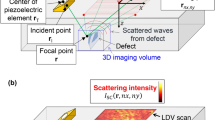Abstract
A system model is presented for the computation of ultrasonic scattering experiments. It includes a two-dimensional transducer model, whose diffraction field is given as an elastic plane wave spectral decomposition. An electromechanical reciprocity theorem is used to calculate the voltage at the terminal of the receiver. As a flaw-model, we use a strip-like crack, whose scattered field is calculated by the elastodynamic Huygens principle including mode conversion effects. Results in the time domain are presented for LLT- and 45° -tandem inspection situations and compared with measurements. Agreement between the model predictions and experimental results is typical to within 2 dB for average scan amplitudes.
Similar content being viewed by others
References
R. K. Chapman, An integrated model of ultrasonic NDT and its practical application, inMathematical Modeling in Non-Destructive Testing, M. Blakemore and G. A. Georgiou, eds., (Clarendon Press, Oxford, 1988).
F. Walte, W. Gebhardt, S. Ekinci, and Z. Jaszcuk, Ultraschallprüfung unter Benutzung der Wellenumwandlung. Teil II: Auslegung von Ultraschallprüfköpfen für die LLT-Technik,Materialprüfung 30:10 (1988).
J. A. Ogilvy, Model for the ultrasonic inspection of rough defects,Ultrasonics 27:69 (1989).
N. F. Haines, A Practical Model of Ultrasonic Reflection from Planar Surfaces, CEGB Report RD/B/N4995.
R. B. Thompson and T. A. Gray, A model relating ultrasonic scattering measurements through liquid-solid interfaces to unbounded medium scattering amplitudes,J. Accoust. Soc. Am. 74:1279 (1983).
B. A. Auld, General electromechanical reciprocity relations applied to the calculation of elastic wave scattering coefficients,Wave Motion 1:3 (1979).
P. Fellinger, Ein Verfahren zur numerischen Lösung elastischer Wellenausbreitungsprobleme im Zeitbereich durch direkte Diskretisierung der elastodynamischen Grundgleichungen, Dissertation am Lehrstuhl für Theoretische. Elektrotechnik der Universität-GH Kassel, Kassel, 1990.
K. J. Langenberg, U. Aulenbacher, G. Bollig, P. Fellinger, H. Morbitzer, G. Weinfurter, P. Zanger, and V. Schmitz, Numerical modeling of ultrasonic scattering,Mathematical Modeling in NonDestructive Testing, M. Blakemore and G. A. Georgiou, eds. (Clarendon Press, Oxford, 1988).
J. D. Achenbach, A. K. Gautesen, and H. McMaken,Ray Methods for Waves in Elastic Solids (Pitman, Boston, 1982).
Author information
Authors and Affiliations
Rights and permissions
About this article
Cite this article
Schuhmacher, S., Zanger, P. & Langenberg, K.J. A system model to predict the results of ultrasonic scattering experiments. J Nondestruct Eval 13, 147–154 (1994). https://doi.org/10.1007/BF00728252
Received:
Revised:
Issue Date:
DOI: https://doi.org/10.1007/BF00728252




